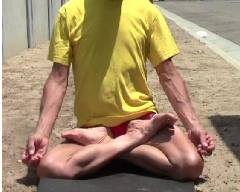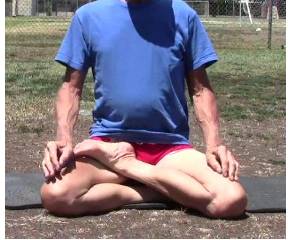use the back browser to return to previous section
Informal Lotus Position
Warning: Both lotus and half-lotus positions are to be attained very gradually. Do not proceed against pain in the knees. If you force yourself into these positions against pain, it can damage your knees. Go slowly -- a little more each day -- no hurry. If one or both knees hurt, let the postures go and just use easy pose -- either cross-legged or sitting on the heels. (When I sit on my heels, the feet are making a V-shape, but I have short legs, and my feet are slightly pigeon-toed.)
There1 are a number of forms of Lotus Position in serious spiritual yoga. The main two are called Padmasana and Siddhasana, and are somewhat difficult of attainment. But if you just put one ankle on the opposite thigh, and the other ankle on its own opposite thigh, close to the crease, it is arguably a lotus position.
Informal Lotus Position
The half-lotus, virasana, is an excellent preparation for this pose. Spend some time each day in virasana left, then virasana right.
The Half-Lotus (Virasana)
Prepared for in this way, the informal lotus is not that difficult of attainment, and it is a useful posture, for two reasons. First, escaping from its discomfort can strengthen concentration. There is motivation to put the mind elsewhere, to get away from the not-too-intense-but-difinitely-annoying pain, and this motivation has power behind it, from the subconscious. That force can empower a meditation.
The other reason is that your feet are compressing the femoral arteries, reducing the flow of blood to the legs, and hence increasing the amount of blood (therefor oxygen) that flows to the brain.
The zafu cushion, illustrated in the Half-Lotus section, is good for this pose also.
space line


